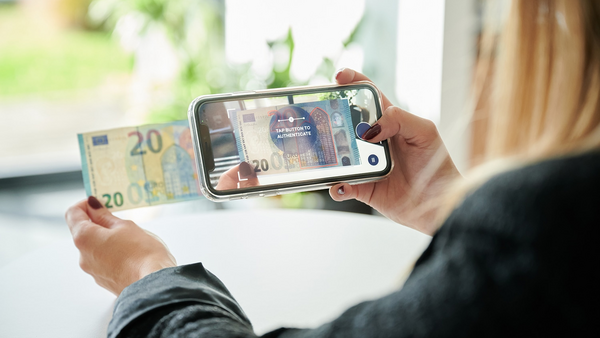In 2021, the number of counterfeit euro banknotes withdrawn from circulation was at a historically low level. Among other things, this is due to the fact that banknotes are becoming increasingly counterfeit-proof. The cooperation between Koenig & Bauer Banknote Solutions and the Institute for Industrial Information Technology (inIT) at the OWL University of Applied Sciences and Art is making an important contribution to this. It enables new authentication solutions that work via smartphone. The joint venture coverno was now integrated into Koenig & Bauer's core business.
Koenig & Bauer Banknote Solutions and the Institute for Industrial Information Technology (inIT) of the OWL University of Applied Sciences and Arts (TH OWL) have a long-standing cooperation in research in the field of banknote authentication and new digital concepts for banknotes. As part of the cooperation, the machine readability of intaglio and other printing processes was made possible with the one-of-its-kind patented technology "Sound of Intaglio®" through a joint company. The joint venture coverno was recently incorporated into Koenig & Bauer's core business to establish a brand new authentication platform called ValiCash™. Here the successful cooperation in the sense of industrialisation of research could be demonstrated and research cooperation in the field of industrial image processing, artificial intelligence and machine learning will be pursued further.
Unique printing processes
Intaglio and other special printing processes have long been used in banknote and high security document production. At the Institute for Industrial Information Technology (inIT) of TH OWL in Lemgo, researchers have developed a method to evaluate steel engraving and other printing processes using image processing methods to reliably authenticate banknotes.
"In the Sound of Intaglio® research project, we were able to successfully show that the steel engraving print, which can easily be felt and seen, can also unambiguously be evaluated using image processing and pattern recognition methods and has thus become a machine-readable security feature," explains Prof Volker Lohweg, project manager and institute director at inIT. In the meantime, the inIT scientists have significantly expanded the procedure. Prof Helene Dörksen, who actively contributed to the project for many years, adds: "We are now also able to assess other important processes such as simultan offset printing in terms of their quality and authenticity."
Julian Schubert, former managing director of coverno and current head of Data, Vision and Authentication Solutions at Koenig & Bauer, comments: "The close cooperation with TH OWL makes it possible to always be one step ahead with innovative technologies. In this way, the joint cooperation has enabled us to bring the traditional but highly secure intaglio printing process to a completely new dimension, namely machine readability. This allows new, scalable authentication solutions for everyone, as a banknote can be verified by a simple photo with a smartphone."
The term intaglio comes from the Italian "intagliare" meaning to engrave. In this printing process, a drawing or text is engraved into a printing plate, the ink remains in the indentations and is then transferred to the paper during printing. Intaglio, i.e. steel engraving, is still the most reliable and secure method of producing money - very fine and in high resolution, even complicated patterns can be printed. In addition to the special optical appearance, the printing is three-dimensional, so that, for example, elevations can be felt. This makes banknotes unique and counterfeiters have so far been technically unable to replicate this combination of haptic and optical features.
No additional security features
A key advantage of ValiCash™ and Sound of Intaglio® is that it analyses a printing process that is already used to produce almost all banknotes, meaning that central banks do not have to apply any new or additional security features. They can use this technology on banknotes already in circulation as well as on other high-security printed documents. For example, on tax stamps, product protection labels and birth certificates.
The ValiCash™ app is currently downloadable for free on the Apple App Store for authenticating euro banknotes.
Banknote authentication with the app
To ensure that counterfeit banknotes can be detected not only by central banks but also by laypeople, the team developed a first research version of an app for smartphones, which was presented at the Optical Document Security Conference in San Francisco in 2012. "The app uses image processing and pattern recognition to identify whether banknotes are questionable. This already works with an average camera on a smartphone," says Lohweg. "This could also be a great help for people with visual impairments, for example." In the meantime, the process has been scaled up through collaboration so that it can be used on a wide range of smartphones. In addition, the robustness against environmental influences has been significantly improved and the process itself has been industrialised to a great extent. "Often, as soon as a first prototype is shown, people think that the system is now ready for the market and fully functional. But this is only half the truth, especially in the area of high security applications. A lot of work has gone into industrialising the prototypes to make them robust and reliable," says Schubert. Today, ValiCash™ is firmly integrated into the portfolio of Koenig & Bauer, the only supplier able to provide to customers a complete solution from the design of banknotes to printing presses to quality control and authentication solutions.
ValiCash™ and further research results on banknotes will be presented at the Optical and Digital Document Security Conference in Vienna on 11-13 April 2022, giving the opportunity to test the application live.


